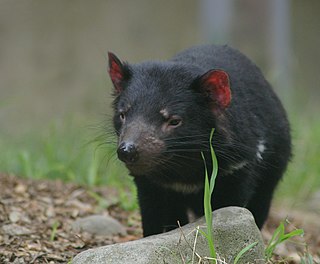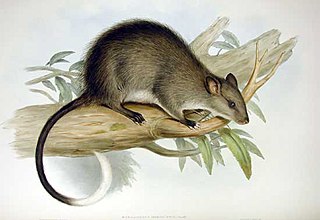
Rosalia, nicknamed la Santuzza, is the patron saint of Palermo in Italy, Camargo in Chihuahua, and three towns in Venezuela: El Hatillo, Zuata, and El Playón. She is especially important internationally as a saint invoked in times of plague. From 2020 onwards she has been invoked by some citizens of Palermo to protect the city from COVID-19.

Kroombit Tops is a national park in Central Queensland, Australia. It is between Monto and Calliope. It is two parts. The largest part is within the localities of Tablelands, Valentine Plains, Cania and Boyne Valley, while the smaller part is in the locality of Mount Alma. It is 399 km northwest of Brisbane. Cania Gorge National Park is located approximately 25 km to the south.

The Dasyuridae are a family of marsupials native to Australia and New Guinea, including 71 extant species divided into 17 genera. Many are small and mouse-like or shrew-like, giving some of them the name marsupial mice or marsupial shrews, but the group also includes the cat-sized quolls, as well as the Tasmanian devil. They are found in a wide range of habitats, including grassland, underground, forests, and mountains, and some species are arboreal or semiaquatic. The Dasyuridae are often called the 'marsupial carnivores', as most members of the family are insectivores.

The dibbler is an endangered species of marsupial. It is an inhabitant of the southwest mainland of Western Australia and some offshore islands. It is a member of the order Dasyuromorphia, and the only member of the genus Parantechinus. The dibbler is a small, nocturnal carnivore with speckled fur that is white around the eyes.

The yellow-footed antechinus, also known as the mardo, is a shrew-like marsupial found in Australia. One notable feature of the species is its sexual behavior. The male yellow-footed antechinus engages in such frenzied mating that its immune system becomes compromised, resulting in stress–related death before it is one year old.

Antechinus is a genus of small dasyurid marsupial endemic to Australia. They resemble mice with the bristly fur of shrews.

The chestnut dunnart is a dunnart that was described by Van Dyck in 1986 and is named because of its chestnut colour in the upperparts of its body. The length from snout to tail is 167–210 mm, of which head to anus is 85–105 mm and tail is 82–105 mm long. The hind foot size is 17–20 mm, ear length is 17–21 mm and weight is 15–20 g.

The black-footed tree-rat, also known as Djintamoonga, is one of two endemic Australian rodent species in the genus Mesembriomys. Both the black-footed tree-rat and its congener, the golden-backed tree-rat, are found in northern Australia. The species is one of the largest murids found in Australia.

The Alexandria false antechinus, also known as the Carpentarian false antechinus or Carpentarian pseudantechinus, is a small carnivorous marsupial, found only in a number of small, isolated localities in northern Australia. It is the smallest and rarest of the false antechinuses.

The Atherton antechinus, also known as Godman's antechinus, is a species of small carnivorous, insectivorous marsupial native to Australia. It is one of the rarest members of its genus, and differs from other antechinuses in its more rufous body colour and small eyes.

The brown antechinus, also known as Stuart's antechinus and Macleay's marsupial mouse, is a species of small carnivorous marsupial of the family Dasyuridae. The males die after their first breeding season, and the species holds the world record for being the world's smallest semelparous mammal.

Entry of Christ into Jerusalem is a 1617 oil painting by Flemish artist Anthony van Dyck, located in the Indianapolis Museum of Art, which is in Indianapolis, Indiana. It depicts Jesus entering Jerusalem as described in the Gospels, the event celebrated on Palm Sunday.

Magistrate of Brussels is an unfinished oil painting or oil sketch by Anthony van Dyck, rediscovered in 2013 after being shown on episodes of the BBC television programme Antiques Roadshow.
Antechinus arktos, the black-tailed antechinus, is a species of small carnivorous marsupial native to Australia.

The silver-headed antechinus is a species of dasyurid marsupial of the genus Antechinus. Described in 2013, the species is known only from so far is known to occur in just three locations: Blackdown Tableland National Park, Kroombit Tops National Park and Bulburin National Park in central Queensland. It is one of the most recently described Australian marsupials.

Saint Rosalia Crowned by Angels is an oil on canvas painting by the studio of Anthony van Dyck, created c. 1624, one of several works showing the saint produced whilst van Dyck was quarantined in Palermo, Sicily due to a plague. It is now in the Galleria Regionale del Palazzo Abatellis in Palermo, where in 2015 it was displayed alongside Saint Rosalie Interceding, loaned from the Metropolitan Museum of Art.
Antechinus vandycki, the Tasman Peninsula dusky antechinus, is a species of marsupial in the family Dasyuridae. It was first described in 2015 by Andrew Baker and his group of scientists in southeast Tasmania. In October 2021, only eight specimens were known.














